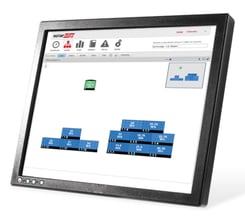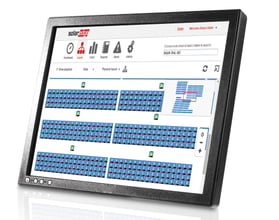
SolarEdge inverters generate more power from a solar PV array than standard string inverters. The additional power generated will depend on the specifics of the installation, but the uplift can be as much as 25%.
The SolarEdge system achieves this by optimising the power output of each individual panel.
In a PV system, each panel has an individual maximum power point. Power output will be reduced by things like:
With traditional string inverters, all panels perform at the level of the weakest panel. With SolarEdge, each panel has its own power optimiser, enabling it to output the maximum power regardless of the behaviour of other panels.
Over time, the differences add up. Here is a commercial case study demonstrating the 4.8% difference in output achieved by SolarEdge over 20 years.
SolarEdge inverters also offer a host of other benefits which are unmatched by any other inverter manufacturer - these are covered in 'Benefits of SolarEdge' below. They are one of the best - if not the best - inverters on the market... almost 2 GW of capacity has been installed throughout 74 countries.
 Standard inverters connect the panels in series which means that the system will always be limited by the lowest performing panel.
Standard inverters connect the panels in series which means that the system will always be limited by the lowest performing panel.
SolarEdge counteracts this by having a power optimiser for each panel to adjust their output to their maximum. The power optimiser (shown right) is connected to the back of each panel, at roof level.
These then connect to the SolarEdge inverter, as shown in the schematic below:

With commercial systems (>15 kW), there may be one optimiser for every two panels, which offers a more cost-effective solution at scale.
As well as the increased power output, SolarEdge offers additional benefits as follows:
SolarEdge offers panel level monitoring for residential and commercial systems via an online portal:
 |
 |
You can also monitor, control and resolve routine issues with your system through the mySolarEdge app:
With all these benefits, you may be thinking why would anyone ever not install SolarEdge. The main reason is that it adds approximately 10-15% to the overall project cost which not everyone can justify.
The added downside, is that if one of the power optimisers malfunctions, while it may be under warranty from SolarEdge, the labour and access costs of installing the replacement will only be covered if the installer has covered it. And this cost will be high if scaffolding is required for roof access. Spirit Energy gives a 5 year Workmanship Warranty on domestic installs, and we would cover the cost in the first 5 years, but after that the access and installation costs for any replacement would fall to the system owner.
That said, the technology has been operational for several years now, and while early versions had their faults, the fault level on the latest generation of equipment is very very low.
SolarEdge makes most financial sense when there is shading involved. However, even without shading it can be justified through the enhanced output, safety, warranty and monitoring features.
In summary, if you want the best possible system and are happy to spend more on top quality, then a SolarEdge inverter is for you. However, if you just want a simple solar PV system that does what it says on the tin, then you're better off with a standard inverter without the extra cost.
Get in touch today to discuss if SolarEdge is best for your system:
Micro-inverters and power optimisers, address the shortcomings of traditional PV systems by managing the system at the panel level and not at the string level.
Both micro-inverters and power optimisers achieve higher energy harvest than traditional string or central inverters, through panel-level Maximum Power Point Tracking (MPPT). Additionally, panel-level electronics offer enhanced maintenance and greater system performance visibility via panel-level monitoring, enhanced safety through automatic voltage shutdown and design flexibility.
However, SolarEdge have themselves produced this comparison between power optimisers and micro-inverters, entitled '8 Ways Power Optimizers Are Better by Design'.
Find out more on the SolarEdge website.
Copyright © Spirit Energy 2025 · info@spiritenergy.co.uk · 0118 951 4490
Jobs and Careers
Interested in joining the Spirit team? Email jobs@spiritenergy.co.uk
Spirit House, 25 Albury Close, Reading, RG30 1BD
(Location formerly known as 44 Portman Road, Reading, RG30 1EA)
Spirit Energy is the trading name of Spirit Solar Ltd · UK Company Number 07138647
Although care is taken to ensure that the information on our website (www.spiritenergy.co.uk) and any guides, calculators or checklists provided by us, electronically or otherwise, are accurate and up-to-date, we cannot accept any responsibility for mistakes or omissions. We enter into no express or implied conditions, warranties, terms or representations regarding the quality, accuracy or completeness of the information. We exclude to the extent lawfully permitted all liability for loss or damage, whether direct, indirect or consequential arising out of your use of our website or any guides, calculators or checklists provided by us, or from any information or omission contained in our website or any guides, calculators or checklists provided by us.